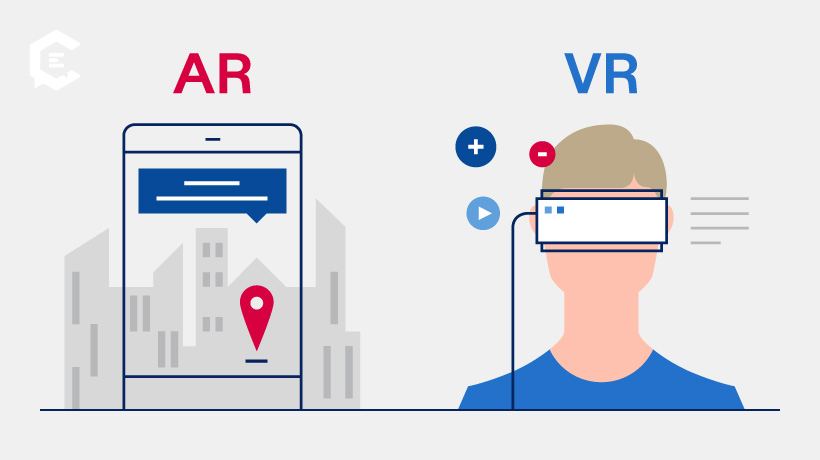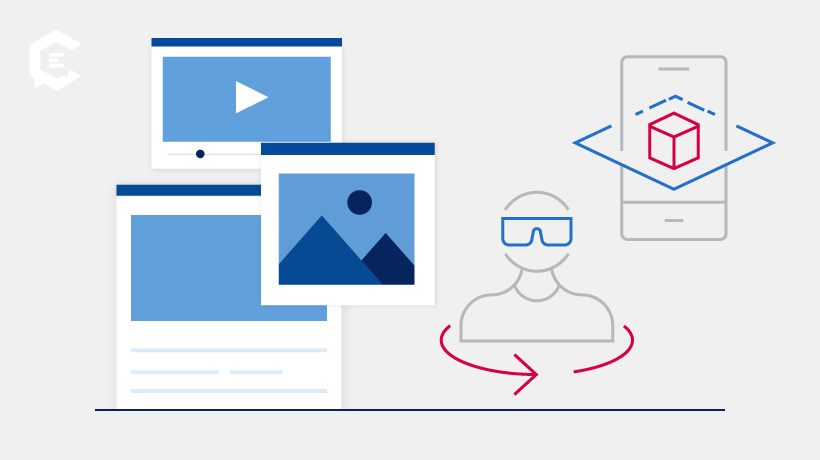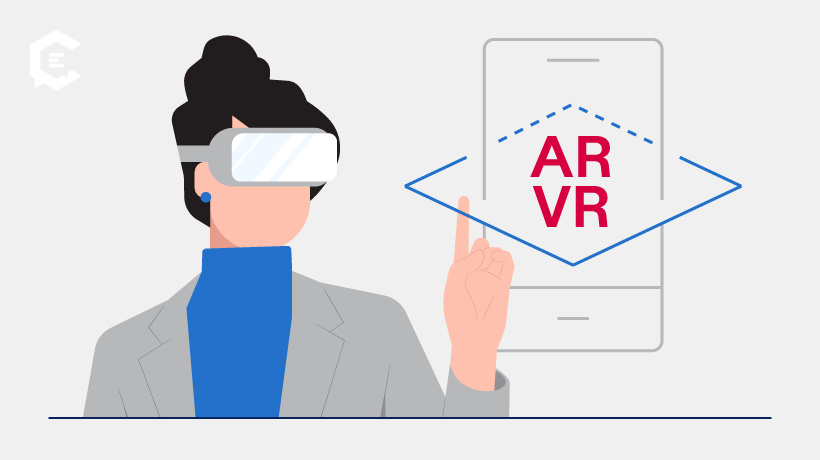Remember the first time you played a virtual reality (VR) or augmented reality (AR) video game? Going from a Super Mario-type experience to the immersive world of VR/AR is enough to make anyone’s heart pump a little harder and smile stretch a little wider.
Now, imagine giving your customers that feeling with your marketing.
AR and VR aren’t just for gamers anymore. These experiential marketing technologies captivate audiences, helping you increase customer loyalty, leads, and sales.
In this guide, you’ll learn what AR and VR are and how you can use them to boost engagement and future-proof your content marketing strategy.

What is Augmented Reality vs. Virtual Reality?
Augmented reality overlays digital elements onto a user’s physical environment, typically through a smartphone, AR headset, or smart glasses. This technology lets you create interactive marketing experiences like allowing customers to “try” products or visualize them in their own space.
For instance, let’s say you sell furniture. A customer can open your app on their phone, point their camera at their living room, and see how your couches, armchairs, and coffee tables would look in their space.
Prefer to give your customers a fully immersive experience? Virtual reality creates a digital environment that users can explore and interact with through a VR headset or other technology. This includes virtual tours of features, product demonstrations, and virtual events.
For example, a travel agency can provide a virtual tour of a vacation rental. The customer can use either a virtual reality headset, mobile device, or computer to walk through each room. They can choose which room to enter and check out amenities, the view from a window, artwork, plants, or even dishes perched on shelves.
With these definitions in hand, let’s explore ways you can use AR and VR in your content marketing strategy.
5 Creative Ways to Use AR and VR to Enhance Your Content Marketing
AR and VR are powerful storytelling tools that enable customers to experience your brand firsthand from anywhere in the world, at any time of day or night. Whether you’re selling physical products, services, or experiences, immersive content helps people see, feel, and understand what sets you apart.
Below are some creative yet accessible ways to use AR and VR marketing for your brand.
1. VR Tours
Virtual reality marketing involves creating a digital representation of a product or experience. In addition to tourism companies, nearly any business that wants to highlight their offering, office, or venue can benefit from VR tours:
- Educational institutions can provide virtual tours of their campuses.
- Real estate companies can give prospective buyers VR tours of homes and properties they’re selling.
- Logistics businesses can provide VR tours of their warehouses.
- Factories can give clients virtual tours of their manufacturing facilities.
2. AR Product Demos
Augmented reality marketing allows customers to see and interact with a digital version of your product in their environment. No matter the industry — retail, automotive, beauty, healthcare, or B2B tech — AR demos help customers understand, evaluate, and connect with your product before they buy.
For example, customers can:
-
Visualize different makeup shades directly on their face.
-
Explore a 3D model of a complex machine or medical device from every angle.
-
Compare interior finishes and features in a new car.
-
Scan packaging or a brochure to trigger a 3D walkthrough of your product or process.
3. QR Codes with an AR Twist
AR-enhanced QR codes let customers scan a code to launch an immersive, interactive experience featuring your product or service.
For example, if you sell a product with intricate specs or components, you could add a QR code to your business card. When scanned, it triggers a 3D video superimposed on the card and walks the customer through each feature and selling point.
4. VR Office Tours
Provides customers with a more intimate understanding of your company by allowing them to take a virtual tour of your location or workspace. Let potential customers tour your gym, restaurant, wedding venue, hotel, or more — the possibilities are endless.
For instance, you could send potential clients a link to a VR tour of your office. They can “meet” the team and even engage in generative AI-powered conversations with each team member to get to know a little about them.
5. Immersive Educational Content
AR and VR marketing can also help you build authority and trust through content. But think beyond the traditional blog post with immersive content that teaches, explains, or entertains (or does all three).
For example:
- A healthcare brand could offer a VR explainer that walks users through how a treatment works inside the body.
- A B2B software company might build an AR experience that visualizes key industry trends or challenges using interactive data and storytelling.
- A financial services firm could educate users on investment strategies through interactive real-world simulations.
These experiences immerse users in your expertise, helping you stand out as a thought leader in your space.
3 Standout Examples of AR and VR Marketing
Here’s how three major brands are using this technology to make marketing more interactive, valuable, and entertaining for consumers.
1. Domino’s
Domino’s uses AR marketing in creative (and tasty) ways. In a past campaign, customers used an app to try on aviator sunglasses with reflections of pizza in the lenses. Upon switching to the rear camera, a Domino’s pizza box appeared on screen, complete with a pepperoni pizza inside. Users could augment the pizza with their preferred toppings and order the pizza without leaving the app.
2. IKEA
The interactive IKEA Place app lets customers preview 3D models of furniture and home goods in their actual space using their smartphone camera. This try-before-you-buy feature has multiple benefits: It boosts buyer confidence and conversion rates while also helping to reduce returns.
Patron
Patrón designed a VR application called “The Art of Patron Virtual Reality Experience,” which immerses users in a tour of its distillery in Jalisco, Mexico. Tequila drinkers can stroll through fields of agave, watch the harvesting process, and see craftspeople roast, crush, and distill the agave into tequila.
Users can even experience the app through the eyes of a bee, which is Patron’s mascot. From this perspective, users become an integral part of the process as they play the role of the invaluable insect that pollinates the agave plant.
Enrich Your Content Marketing with AR and VR
AR and VR marketing give your customers and prospects a uniquely impactful and intimate experience with your product or service. Whether it’s a product preview or virtual tour, these technologies help customers connect with your brand on a deeper level. It also makes your content more engaging, educational, and memorable.
Need help crafting the story behind your immersive content?
ClearVoice’s content experts can write the scripts, messaging, and narratives that bring your AR/VR experiences to life. Connect with a content specialist to learn more.





